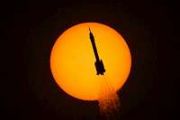
Copernical Team
Gilmour Space signs first European partnership agreement with Exolaunch
 Gilmour Space Technologies, a premier Australian rocket company pioneering new and innovative hybrid propulsion technologies for launching small satellites, and Exolaunch, a Berlin-based leader in rideshare launch and deployment services for small satellites, has announced a series of agreements for small satellite launch, deployment and in-space transportation services.
Under the agreemen
Gilmour Space Technologies, a premier Australian rocket company pioneering new and innovative hybrid propulsion technologies for launching small satellites, and Exolaunch, a Berlin-based leader in rideshare launch and deployment services for small satellites, has announced a series of agreements for small satellite launch, deployment and in-space transportation services.
Under the agreemen Interstellar comets like Borisov may not be all that rare
 In 2019, astronomers spotted something incredible in our backyard: a rogue comet from another star system. Named Borisov, the icy snowball traveled 110,000 miles per hour and marked the first and only interstellar comet ever detected by humans.
But what if these interstellar visitors-comets, meteors, asteroids and other debris from beyond our solar system-are more common than we think?
In 2019, astronomers spotted something incredible in our backyard: a rogue comet from another star system. Named Borisov, the icy snowball traveled 110,000 miles per hour and marked the first and only interstellar comet ever detected by humans.
But what if these interstellar visitors-comets, meteors, asteroids and other debris from beyond our solar system-are more common than we think? UCF experimental space dirt used by NASA, private companies to advance space exploration
 An ingenious idea born out of a research lab at the University of Central Florida has led to a growing operation that is having a direct impact on space exploration.
Chances are that some of the equipment landing on the moon and the methods that will be used to grow food or build shelter, will have been tested first on experimental soil developed right at UCF.
UCF's Exolith Lab has p
An ingenious idea born out of a research lab at the University of Central Florida has led to a growing operation that is having a direct impact on space exploration.
Chances are that some of the equipment landing on the moon and the methods that will be used to grow food or build shelter, will have been tested first on experimental soil developed right at UCF.
UCF's Exolith Lab has p NASA faces new criticism, possible congressional hearing over spacesuit delays
 NASA is facing new criticism over a recent agency watchdog report that disclosed spacesuit development is so far behind schedule that a return to the moon would be delayed beyond a 2024 target.
Coupled with the high cost, estimated to hit $1 billion eventually, the development issues are serious enough to prompt a congressional hearing, U.S. Rep. Don Beyer, D-Va., told UPI.
"I almost
NASA is facing new criticism over a recent agency watchdog report that disclosed spacesuit development is so far behind schedule that a return to the moon would be delayed beyond a 2024 target.
Coupled with the high cost, estimated to hit $1 billion eventually, the development issues are serious enough to prompt a congressional hearing, U.S. Rep. Don Beyer, D-Va., told UPI.
"I almost Planet Aqua: Solutions from Space for Clean Water
 Video:
00:51:12
Video:
00:51:12
Water is life, on Earth and in space. Dutch ESA astronaut André Kuipers recounts his experience living in space for 204 days, and his time looking back on the blue face of ‘Planet Aqua’, comparing notes with divers about what is going on beneath the waves. He goes on to explore how space technology is being used for water management, from orbital tracking of water quality and pollution to spacecraft-grade recycling systems deployed down on the ground, as well as ambitious efforts to identify marine plastic litter using satellites. Produced for SIWI World Water Week with the
Astronaut's undisclosed minor medical issue delays spacewalk

NASA is delaying a spacewalk at the International Space Station this week because of an undisclosed medical issue involving one of its astronauts.
We're launching Australia's first scratch-built satellite, and it's a giant leap toward the moon

On August 28, a SpaceX rocket will blast off from Cape Canaveral in Florida, carrying supplies bound for the International Space Station. But also on board will be a small satellite that represents a giant leap into space for our research program here in Western Australia.
Our satellite, called Binar-1 after the Noongar word for "fireball," was designed and built from scratch by our team at Curtin University's Space Science and Technology Center.
We chose this name for two reasons: to acknowledge the Wadjuk people of the Noongar Nation, and to recognize the relationship between our satellite program and Curtin's Desert Fireball Network, which has successfully searched for meteorites in the Australian desert.
Binar-1 is a CubeSat—a type of small satellite made from 10-centimeter cube-shaped modules. Binar-1 consists of just one such module, meaning it's technically a 1U CubeSat.
Its main objective is to prove the technology works in space, thereby taking a first step towards future missions in which we hope ultimately to send CubeSats to the moon.
ESA astronaut joins glacier expedition in Alps

From space, the synchronous retreat of the world’s glaciers can be clearly observed. To get a first-hand view of these changes, ESA astronaut Luca Parmitano, along with Susanne Mecklenburg, Head of ESA’s Climate Office, have joined a science expedition taking place at one of the biggest ice masses in the Alps: the Gorner Glacier.
Astronaut applicants asked for patience as numbers exceed forecasts

Astronaut hopefuls are being asked for their patience as ESA processes over 23 000 applications to its Astronaut and Astronaut (with a disability) vacancies. This number far exceeds the Agency’s most optimistic forecasts.
Magnets could offer better control of prosthetic limbs
 For people with amputation who have prosthetic limbs, one of the greatest challenges is controlling the prosthesis so that it moves the same way a natural limb would. Most prosthetic limbs are controlled using electromyography, a way of recording electrical activity from the muscles, but this approach provides only limited control of the prosthesis.
Researchers at MIT's Media Lab have now
For people with amputation who have prosthetic limbs, one of the greatest challenges is controlling the prosthesis so that it moves the same way a natural limb would. Most prosthetic limbs are controlled using electromyography, a way of recording electrical activity from the muscles, but this approach provides only limited control of the prosthesis.
Researchers at MIT's Media Lab have now 
































